The Google Nexus 9 Review
by Joshua Ho & Ryan Smith on February 4, 2015 8:00 AM EST- Posted in
- Tablets
- HTC
- Project Denver
- Android
- Mobile
- NVIDIA
- Nexus 9
- Lollipop
- Android 5.0
CPU Performance
While Denver’s architecture is something fascinating to study, it’s important to see how well this translates to the real world. Denver on paper is a beast, but in the real world there are a number of factors to consider, not the least of which is the effectiveness of NVIDIA’s DCO. We’ve laid out that Denver’s best and worst case scenarios heavily ride on the DCO, and for NVIDIA to achieve their best-case performance they need to be able to generate and feed Denver with lots and lots of well optimized code. If Denver spends too much time working directly off of ARM code or can’t do a good job optimizing the recurring code it finds then Denver will struggle. Meanwhile other important factors are in play as well, including the benefits and drawbacks of Denver’s two cores versus competing SoC’s quad A15/A57 configurations, and in thermally constrained scenarios Denver’s ability to deliver good performance while keeping its power consumption in check.
In order to test this and general system performance, we turn our suite of benchmarks that include browser performance tests, general system tests, and game-type benchmarks. As Denver relies on code-morphing to enable out of order execution and speculative execution, most of these benchmarks should be able to show ideal performance as loop performance in Denver is basically second to none. While most of these benchmarks are showing their age, they should be usable for valid comparisons until we move to our new test suite.
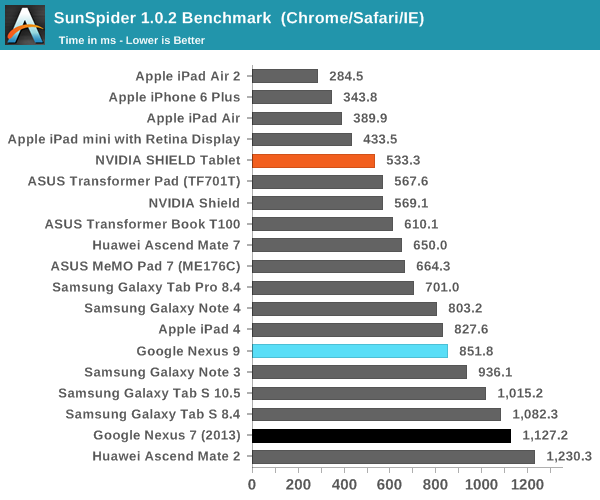
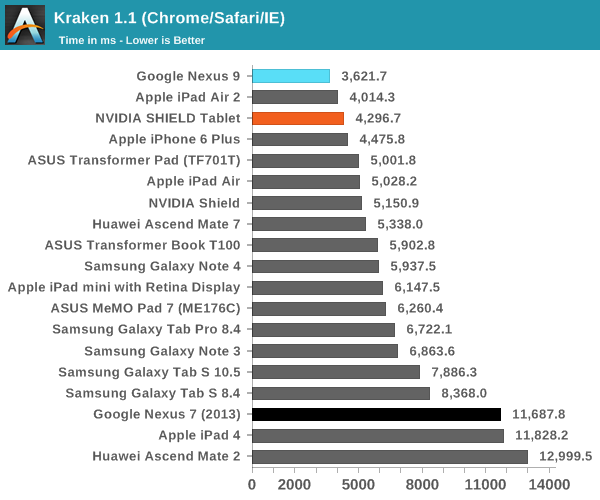
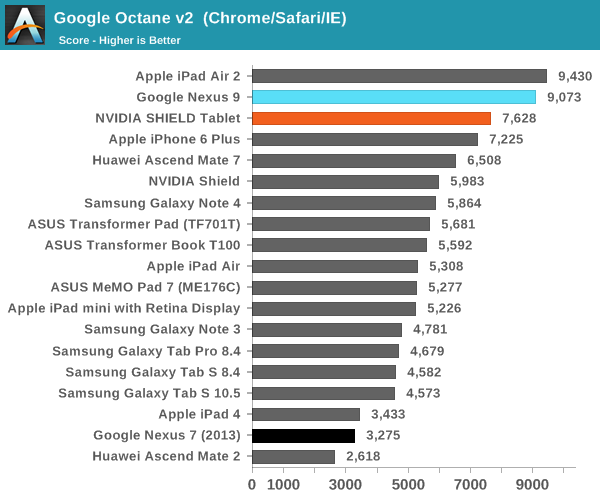

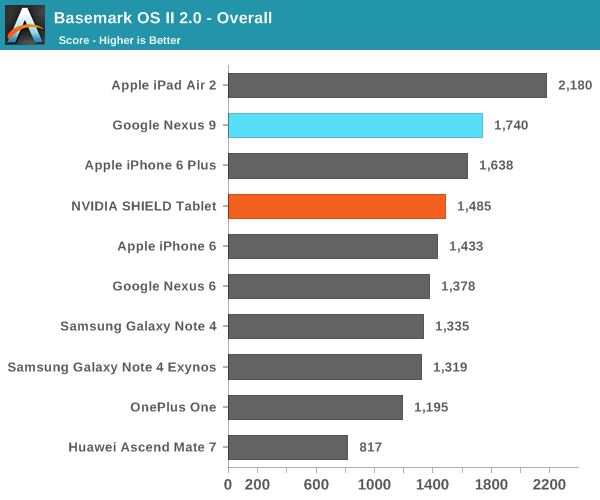

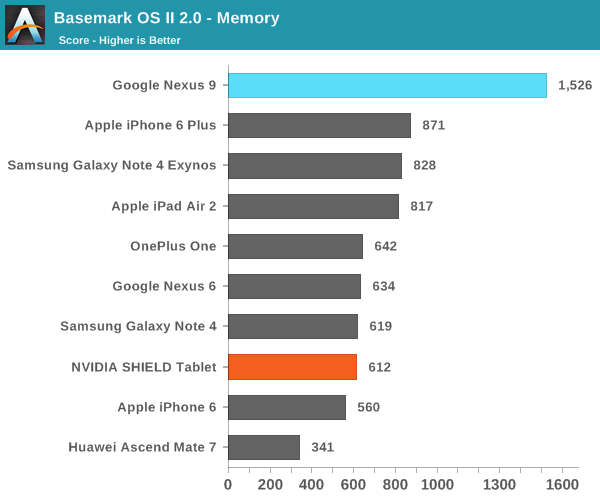
The Basemark System test seems to contribute quite strongly to how the Nexus 9 performs in the overall subtest. Given that this is a storage performance benchmark, it's likely that Basemark OS II has issues similar to Androbench on 5.0 Lollipop or that random I/O is heavily prioritized in this test.
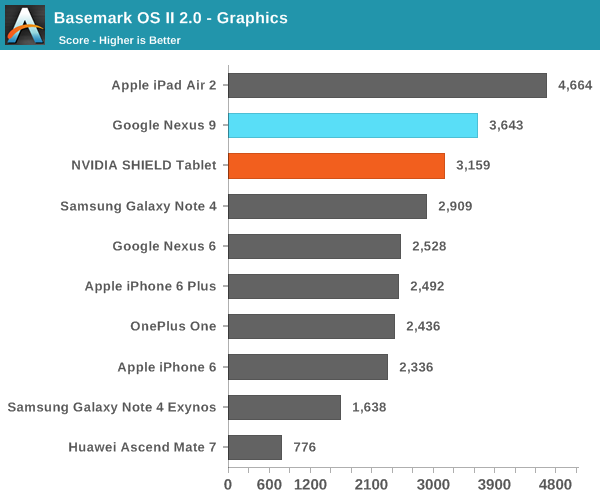
There's a noticeable performance uplift in the graphics test, and although not exactly part of the CPU this does seem at least somewhat plausible as GPU driver updates can improve performance over time.
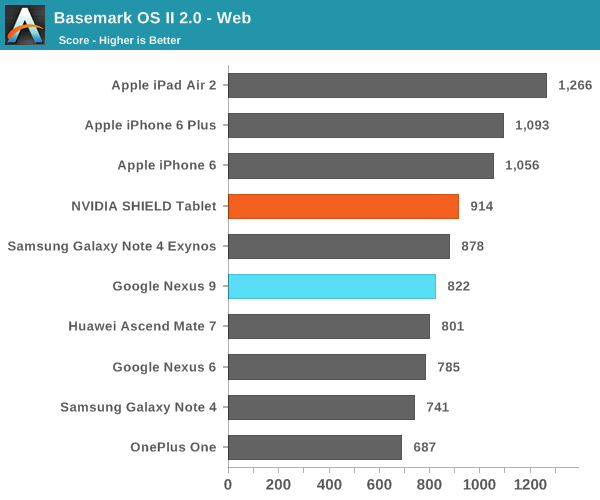
Overall, performance seems to be quite checkered, although improved from our initial evaluation of the Nexus 9. Unfortunately, even in benchmarks where the DCO should be able to easily unroll loops to achieve massive amounts of performance, we see inconsistent performance in Denver. This may come down to an issue with the DCO, or even more simply the fact that Denver is spending more time than it would like to directly executing ARM code as opposed to going through the DCO.
In this case looking at the SunSpider and Kraken javascript benchmarks offers an interesting proxy case for exactly that scenario. SunSpider on modern CPUs executes extremely quickly, so quickly that the individual tests are often over in only a couple of dozen of milliseconds. This is a particularly rough scenario for Denver, as it doesn’t provide Denver with much time to optimize, even if the code is run multiple times. Meanwhile Kraken pushes many similar buttons, but its tests are longer, and that gives Denver more time to optimize. Consequently we find that Denver’s SunSpider performance is quite poor – underperforming even the A15-based Tegra K1-32 – while Denver passes even the iPad Air 2 in Kraken.
Ultimately this kind of inconsistent performance is a risk and a challenge for Denver. While no single SoC tops every last CPU benchmark, we also don’t typically see the kind of large variations that are occurring with Denver. If Denver’s lows are too low, then it definitely impacts the suitability of the SoC for high-end devices, as users have come to expect peppy performance at all times.
In practice, I didn't really notice any issues with the Nexus 9's performance, although there were odd moments during intense multitasking where I experienced extended pauses/freezes that were likely due to the DCO getting stuck somewhere in execution, seeing as how the DCO can often have unexpected bugs such as repeated FP64 multiplication causing crashes. In general, I noticed that the device tended to also get hot even on relatively simple tasks, which doesn't bode well for battery life. This is localized to the top of the tablet, which should help with user comfort although this comes at the cost of worse sustained performance.










169 Comments
View All Comments
philosofa - Wednesday, February 4, 2015 - link
Anandtech have always prioritised quality, insight and being correct, over being the first to press. It's why a giant chunk of its readerbase reads it. This is going to be relevant and timely to 90% of people who purchase the Nexus 9. It's also likely to be the definitive article hardware and tech wise produced anywhere in the world.I'd call that a win. I just think there's no pleasing everyone, particularly the 'what happened to AT????!? crowd' that's existed here perpectually. You remind me of the Simcity Newspaper article 'naysayers say nay'. No: Yea.
iJeff - Wednesday, February 4, 2015 - link
You must be new around here. Anandtech was always quite a bit slow to release their mobile hardware reviews; the quality has always been consistently higher in turn.Rezurecta - Wednesday, February 4, 2015 - link
C'mon guys. This isn't the freakin Verge or Engadget review. If you want fancy photos and videos with the technical part saying how much RAM it has, go to those sites.The gift of Anandtech is the deep dive into the technical aspects of the new SoC. That ability is very exclusive and the reason that Anandtech is still the same site.
ayejay_nz - Wednesday, February 4, 2015 - link
Release article in a hurry and unfinished ... "What has happened to Anandtech..."Release article 'late' and complete ... "What has happened to Anandtech..."
There are some people you will never be able to please!
Calista - Thursday, February 5, 2015 - link
You still have plenty of other sites giving 0-day reviews. Let's give the guys (and girls?) of Anandtech the time needed for in-depth reviews.littlebitstrouds - Friday, February 6, 2015 - link
No offence but your privilege is showing...HarryX - Friday, February 6, 2015 - link
I remember that the Nexus 5 review came out so late and that was by Brian Klug, so it's really nothing unusual here. This review covers so much about Denver that wasn't mentioned elsewhere that I won't mind at all if it was coming late. Reviews like this one (and the Nexus 5 one to a lesser extent, or the Razer Blade 2014 one) are so extensive that I won't mind reading them months after release. The commentary and detailed information in them alone make them worth the read.UtilityMax - Sunday, February 8, 2015 - link
The review is relevant. The tablet market landscape hasn't been changed much between then and now. Anyone in the market for a Nexus 9 or similar tablet is going to evaluate it against what was available at the time of release.SunnyNW - Sunday, February 8, 2015 - link
Only thing that sucks about these late reviews is if you are trying to base your purchase decision on it especially with holiday season.Aftershocker - Friday, February 13, 2015 - link
I've got to agree, Anandtech have dropped the ball on this one. I always prefer to wait and read the comprehensive Anandtech review which I understand can take a few weeks, but this is simply to long to get a review out on a flagship product. Call me sceptical but I can't see such a situation occurring on the review of a new apple product.